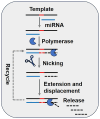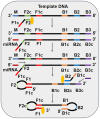Advances in Research on Isothermal Signal Amplification Mediated MicroRNA Detection of Clinical Samples: Application to Disease Diagnosis
- PMID: 40558477
- PMCID: PMC12190449
- DOI: 10.3390/bios15060395
Advances in Research on Isothermal Signal Amplification Mediated MicroRNA Detection of Clinical Samples: Application to Disease Diagnosis
Abstract
With the rapid development of modern molecular biology, microRNA (miRNA) has been demonstrated to be closely associated with the occurrence and development of tumors and holds significant promise as a biomarker for the early detection, diagnosis, and treatment of cancer and other diseases. Therefore, detecting miRNA and analyzing it to determine its biological functions are of great significance for the screening and diagnosis of diseases. However, the intrinsic characteristics of miRNAs, including their low abundance, short sequence lengths, and high family-specific sequence homology, render traditional detection methods such as Northern blot hybridization, microarray use, and reverse transcription quantitative PCR (RT-qPCR) inadequate for meeting the stringent requirements of clinical detection in biological samples, a task requiring accuracy, rapidity, high detection power, specificity, and cost-effectiveness. In recent years, a substantial amount of effort has been put into developing innovative methodologies to address these challenges. In this review, we aim to provide a comprehensive overview of the recent advancements in these methodologies and their applications in clinical biological sample detection for disease diagnosis.
Keywords: disease diagnosis; isothermal signal amplification; miRNA detection; point-of-care testing.
Conflict of interest statement
The authors declare no conflicts of interest.
Figures








Similar articles
-
Rapid molecular tests for tuberculosis and tuberculosis drug resistance: a qualitative evidence synthesis of recipient and provider views.Cochrane Database Syst Rev. 2022 Apr 26;4(4):CD014877. doi: 10.1002/14651858.CD014877.pub2. Cochrane Database Syst Rev. 2022. PMID: 35470432 Free PMC article.
-
Signs and symptoms to determine if a patient presenting in primary care or hospital outpatient settings has COVID-19.Cochrane Database Syst Rev. 2022 May 20;5(5):CD013665. doi: 10.1002/14651858.CD013665.pub3. Cochrane Database Syst Rev. 2022. PMID: 35593186 Free PMC article.
-
Rapid, point-of-care antigen tests for diagnosis of SARS-CoV-2 infection.Cochrane Database Syst Rev. 2022 Jul 22;7(7):CD013705. doi: 10.1002/14651858.CD013705.pub3. Cochrane Database Syst Rev. 2022. PMID: 35866452 Free PMC article.
-
What is the value of routinely testing full blood count, electrolytes and urea, and pulmonary function tests before elective surgery in patients with no apparent clinical indication and in subgroups of patients with common comorbidities: a systematic review of the clinical and cost-effective literature.Health Technol Assess. 2012 Dec;16(50):i-xvi, 1-159. doi: 10.3310/hta16500. Health Technol Assess. 2012. PMID: 23302507 Free PMC article.
-
The use of Open Dialogue in Trauma Informed Care services for mental health consumers and their family networks: A scoping review.J Psychiatr Ment Health Nurs. 2024 Aug;31(4):681-698. doi: 10.1111/jpm.13023. Epub 2024 Jan 17. J Psychiatr Ment Health Nurs. 2024. PMID: 38230967
References
Publication types
MeSH terms
Substances
Grants and funding
LinkOut - more resources
Full Text Sources

